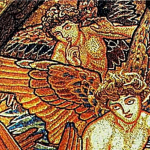Needlepoint in Rock
Needlepoint in Rock
This lively dog still guards his long-dead master’s house in what remains of Pompeii, Italy, centuries after Mount Vesuvius erupted and covered the city in molten ash. He has endured because he is fashioned of stone–of many tiny stones, meticulously cemented into place. The method by which he was made is mosaic, an intriguing art form that thrives today as it did then. It is my new art medium, and I refer to it, somewhat wryly, as “needlepoint in rock.”
My late mother was a needlepointer. Over many years, I was the beneficiary of her prodigious output–needlepointed chair seats, footstools, Christmas ornaments, and stockings. I loved the giver, so I received them gratefully, and respected the perseverance that produced them. But a craft that demanded many hours of labor for very little return was not for me, a carefree, devil-may-care, action (as I thought!) draftsman. Too painstaking, too time-consuming, too tight a finished product, for someone accustomed to drawing with abandon on huge rolls of paper tacked to the wall.

I had similar feelings about the wonders of Ravenna, site of some of the most sublime mosaics ever made. They were awe-inspiring, but inhibiting.
Well. That was then, and this is now. From classes and books, I discovered more contemporary methods of making mosaics, and the veil was lifted. The deliberative process of choosing and shaping pieces of glass induces, not tedium, but the state of timelessness that social scientists nowadays call “flow,” long recognized by monks the world over, as contemplation. Nip. Nibble. Glue. Place. Suspended in the eternal moment, I am thoroughly converted to needlepointing in rock.


